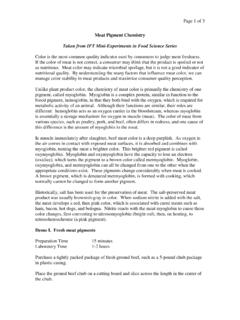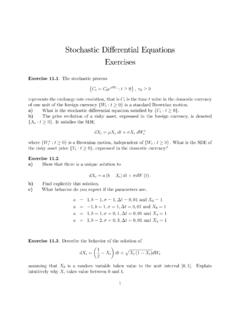Transcription of Stochastic Processes and Advanced Mathematical Finance
1 Steven R. DunbarDepartment of Mathematics203 Avery HallUniversity of Nebraska-LincolnLincoln, NE 68588-0130 : 402-472-3731 Fax: 402-472-8466 Stochastic Processes andAdvanced Mathematical FinanceStochastic Differential equations and theEuler-Maruyama MethodRatingMathematically Mature: may contain mathematics beyond calculus Starter QuestionExplain how to use a slope-field diagram to solve the ordinary differentialequationdxdt= would you turn that process into an algorithm to numerically computean approximate solution without a diagram?Key Concepts1. We can numerically simulate the solution to Stochastic differential equa-tions with an analog to Euler s method, called the Euler-Maruyama(EM) Astochastic differential equationis a Mathematical equation relat-ing a Stochastic process to its local deterministic and random compo-nents.
2 The goal is to extend the relation to find the Stochastic mild conditions on the relationship, and with a specifying initialcondition, solutions of Stochastic differential equations exist and TheEuler-Maruyama (EM) methodis a numerical method forsimulating the solutions of a Stochastic differential equation based on2the definition of the It o Stochastic integral: GivendX(t) =G(X(t)) dt+H(X(t)) dW(t), X(t0) =X0,and a step size dt, we approximate and simulate withXj=Xj 1+G(Xj 1) dt+H(Xj 1)(W(tj 1+ dt) W(tj 1))3. Extensions and variants of standard Brownian motion defined throughstochastic differential equations areBrownian motion with drift,scaled Brownian motion, andgeometric Brownian IdeasStochastic Differential equations : SymbolicallyThe straight line segment is the building block of differential calculus.
3 Thebasic idea behind differential calculus is that differentiable functions, no mat-ter how difficult their global behavior, are locally approximated by straightline segments. In particular, this is the idea behind Euler s method for ap-proximating differentiable functions defined by differential know that rescaling ( zooming in on) Brownian motion does notproduce a straight line, it produces another image of Brownian motion. Thisself-similarity is ideal for an infinitesimal building block, for instance, wecould build global Brownian motion out of lots of local chunks of Brow-nian motion. This suggests we could build other Stochastic Processes outof suitably scaled Brownian motion. In addition, if we include straight linesegments we can overlay the behavior of differentiable functions onto thestochastic Processes as well.
4 Thus, straight line segments and chunks ofBrownian motion are the building blocks of Stochastic Stochastic differential calculus, we can build new Stochastic pro-cesses. We do this by specifying how to build the new Stochastic processes3locally from our base deterministic function, the straight line and our basestochastic process, standard Brownian motion. We write the local change invalue of the Stochastic process over a time interval of (infinitesimal) lengthdtasdX=G(X(t)) dt+H(X(t)) dW(t), X(t0) =X0.(1)Note that we are not allowed to writedXdt=G(X(t)) +H(X(t))dWdt, X(t0) =X0since standard Brownian motion is nowhere differentiable with probability , the informal Stochastic differential equation (1) is a compact way ofwriting a rigorously defined, equivalent implicit It o integral equation.
5 Sincewe do not have the required rigor, we will approach the Stochastic differentialequation Stochastic differential equation says the initial point (t0,X0) is spec-ified, perhaps withX0a random variable with a given distribution. A de-terministic component at each point has a slope determined throughGatthat point. In addition, some random perturbation affects the evolution ofthe process. The random perturbation is normally distributed with mean variance of the random perturbation is (H(X(t)))2at (t,X(t)). This isa simple expression of a Stochastic Differential Equation (SDE) which deter-mines a Stochastic process, just as an Ordinary Differential Equation (ODE)determines a differentiable function. We extend the process with the incre-mental change information and repeat. This is an expression in words oftheEuler-Maruyama methodfor numerically simulating the stochasticdifferential very simple Stochastic differential equation isdX=rdt+ dW, X(0) =bwithra constant.
6 Take a deterministic initial condition to beX(0) =b. Thenew process is the Stochastic extension of the differential equation expressionof a straight line. The new Stochastic processXis drifting or trending atconstant raterwith a random variation due to Brownian motion perturba-tions around that trend. We will later show explicitly that the solution ofthis SDE isX(t) =b+rt+W(t) although it is seems intuitively clear thatthis should be the process. We will call thisBrownian motion with very simple Stochastic differential equation isdX= dW, X(0) =bThis Stochastic differential equation says that the process is evolving as amultiple of standard Brownian motion. The solution may be easily guessed asX(t) = W(t) which has variance 2ton increments of lengtht. Sometimesthe new process is called Brownian motion (in contrast to standard Brownianmotion which has varianceton increments of lengtht).
7 We combine the previous two examples to considerdX=rdt+ dW, X(0) =bwhich has solutionX(t) =b+rt+ W(t), amultiple of Brownian motionwith driftrstarted atb. Sometimes this extension of standard Brownianmotion is called Brownian motion. Some authors consider this process di-rectly instead of the more special case we considered in the previous next simplest and first non-trivial differential equation isdX=XdW .Here the differential equation says that process is evolving like Brownianmotion with a variance which is the square of the process value. When theprocess is small, the variance is small, when the process is large, the varianceis large. Expressing the Stochastic differential equation as dX /X= dWwemay say that the relative change acts like standard Brownian motion. Theresulting Stochastic process is calledgeometric Brownian motionand itwill figure extensively later as a model of security next simplest differential equation isdX=rXdt+ XdW, X(0) = the Stochastic differential equation says that the growth of the processat a point is proportional to the process value, with a random perturbationproportional to the process value.
8 Again looking ahead, we could write thedifferential equation as dX /X=rdt+ dWand interpret it to say therelative rate of increase is proportional to the time observed together with arandom perturbation like a Brownian increment corresponding to the lengthof time. We will show later that the analytic expression for the stochasticprocess defined by this SDE isbexp((r 12 2)t+ W(t)).5 Stochastic Differential equations : NumericallyThe sample path that the Euler-Maruyama method produces numerically isthe analog of using the Euler formula for the Euler-Maruyama (EM) method is based on the defi-nition of the It o Stochastic integral:Xj=Xj 1+G(Xj 1) dt+H(Xj 1)(W(tj 1+ dt) W(tj 1)),tj=tj 1+ that the initial conditionsX0andt0set the starting this text, we use coin-flipping sequences of an appropriate lengthscaled to create an approximation toW(t) just as in the section Approx-imation to Brownian Motion.
9 The coin-flipping sequences emphasize thediscrete nature of the simulations with an easily constructed random pro-cess. This is consistent with the approach of this text which always usescoin-flipping sequences to create random Processes . Note that since the in-crementsW(tj 1+ dt) W(tj 1) are independent and identically distributed,we will use independent coin-flip sequences to generate the approximation ofthe increments. The EM method could use independent normal randomvariates directly to obtain the incrementsW(tj 1+ dt) W(tj 1). Usingindependent normal random variates directly would be easier and more effi-cient. The exercises modify the example scripts to use independent normalrandom variates (tj 1+ dt) W(tj 1) =W( dt) WN( dt) = W(Ndt) N= dt W(Ndt) first equality above is the definition of an increment, the second equal-ity means the random variablesW(tj 1+ dt) W(tj 1) andW( dt) havethe same distribution because of the definition of standard Brownian motionwhich specifies that increments with equal length are normally distributedwith variance equal to the increment length.
10 The approximate equality oc-curs because of the approximation of Brownian motion by coin-flipping se-quences. We generate the approximations using a random number generator,but we could as well use actual coin-flipping. In Table 1 the generation ofthe sequences is not recorded, only the summed and scaled (independently6jtjXj2 XjdtdWXjdW2 Xjdt+Xj+XjdW2 Xjdt+ 1: Simulation with the Euler-Maruyama method of a process definedby a Stochastic differential ) outcomes. For convenience, take dt= 1/10,N= 100, so we need W(100 (1/10))/ 100 =T10/10. Then to obtain the entries in the columnlabeleddWin the table we flip a coin 10 times and recordT10/10. Taker= 2,b= 1, and = 1, so we simulate the solution ofdX= 2 Xdt+XdW, X(0) = computer program can produce such a table with the step size made muchsmaller, presumably resulting in better approximation properties.















